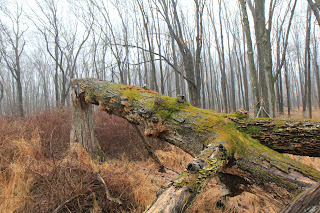I wasn't given much guidance on what to do if the tour groups had chosen to do the hike in the woods, though. My brother suggested I might find some ideas in a book called Sharing Nature with Children by Joseph Cornell. Filled with suggestions on how to get kids interested in and excited about being outside, the book inspired me as well. There was the Web of Life game, which uses a simple roll of twine to teach the interconnectedness of all living things, and the Know a Tree exercise, where one child in a pair is blindfolded, and learns about a single tree just through touching it--and has to try to find it later once she can see.
More than three decades later, I still find myself using some of the techniques in that book. For example, the other day, I took a micro-hike. Now, the way the book describes it--and the best way to do it with a bunch of unruly children--is to take a hula hoop and put it on the ground and have the kids look really closely at what they could see, just within the confines of the hoop. If you've never taken the time to explore a small section of the earth (and by small I mean one or two square feet), I highly recommend it--particularly in the spring and summer.
I used to do this exercise before we went into Helyar Woods, because it taught the kids to be observant--and to be excited about discovering things, even things that might seem boring. They would notice bugs, and ants, and sticks. They'd realize that all grass doesn't look the same, and there might be clover and dandelions and thistle mixed in. Someone would invariable find bird poop, but it was ever so much more exciting when we talked about what bird it might have been, and how you can tell things about a living creature from examining what it eliminates.
The other day, I was inspired to do a version of the micro hike in the woods behind my house. The hike was along a fallen tree--one that had come down a few years ago. Since I brought my camera--and a macro lens--you can come with me.
 |
| The micro hike takes place here. |
There's moss and fungus and lichen!
And here's where I wish I had a resident expert to help me a bit. I think most of us can recognize moss.
 |
| Moss |
And probably we would know what a fungus looks like, particularly when we remember that a mushroom is a fungus.
But lichen?
 |
| Lichen! (and moss) |
Actually, now that I realize it, what the heck is a lichen exactly? A little bit of research has helped me learn a little about these fascinating organisms. For one thing they are true symbionts. A lichen is a composite of a fungus and a photosynthetic organism--usually an alga. Fungus get food from the algae's photosynthesis, and the algae get moisture from the fungus.
Lichens live in the most inhospitable environments--on rocks, logs, walls--and in harsh climates. They occupy a niche that other organisms can't survive. Though they also apparently are very sensitive to pollutants, and are indicators of poor air quality; no lichens = possible air pollution. I guess they're the plant versions of the canary in a coal mine.
On most of my other posts I can identify some of the plants and animals and insects in the photographs I feature. But in this case, I can just barely do that with lichens. But here's the thing, they sure are pretty. And quite fascinating. And make great subjects for a micro hike with a camera.
To sit back, relax, and enjoy the hike. I'll identify where I can.
 |
| The bottom of the log, where it meets the ground, shows grass, lichens and moss. |
 |
| Moss on the top of the log shows tiny stalks that have captured water droplets. |
 |
| I believe this is called turkey tail lichen. |
 |
| This is really young turkey tail lichen. Each of these little fruiting bodies are no more than a quarter inch tall, |
 |
| These turkey tails are a little bigger. You can also see some moss--that's the dark green--and the lighter green is a common greenshield lichen, I think. |
 |
| Here is a combination of all the mosses and lichens, young and old. |
 |
| A close up of turkey tail lichen. |
 |
| Seems like the turkey tail lichen can feature several colors...though I'm not sure. |
And sometimes, that's enough.










































